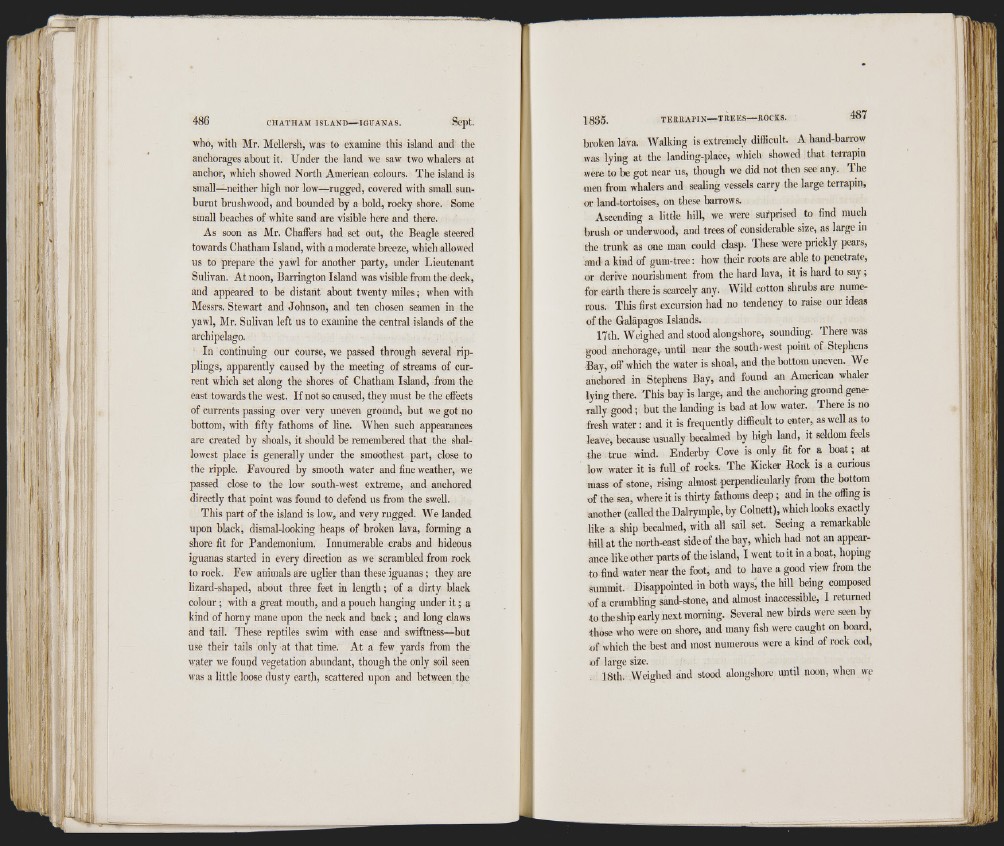
I V.
who, with Mr. Mellersh, was to examine this island and the
anchorages ahout it. Under the land we saw two whalers at
anchor, which showed North American colours. The island is
small—neither high nor low—rugged, covered with small sunburnt
brushwood, and bounded by a bold, rocky shore. Some
small beaches of white sand are visible here and there.
As soon as Mr. Chaffers had set out, the Beagle steered
towards Chatham Island, with a moderate breeze, which allowed
us to prepare the yawl for another party, under Lieutenant
Sulivan. At noon, Barrington Island was visible from the deck,
and appeared to be distant about twenty miles; when with
Messrs. Stewart and Johnson, and ten chosen seamen in the
yawl, Mr. Sulivan left us to examine the central islands of the
archipelago.
In continuing our course, we passed through several ripplings,
apparently caused by the meeting of streams of current
which set along the shores of Chatham Island, from the
east towards the west. If not so caused, they must be the effects
of currents passing over very uneven ground, but we got no
bottom, with fifty fathoms of line. When such appearances
are created by shoals, it should be remembered that the shallowest
place is generally under the smoothest part, close to
the ripple. Favoured hy smooth water and fine weather, we
passed close to the low south-west extreme, and anchored
directly that point was found to defend us from the swell.
This part of the island is low, and very rugged. We landed
upon black, dismal-looking heaps of broken lava, forming a
shore fit for Pandemonium. Innumerable crabs and hideous
iguanas started in every direction as we scrambled from rock
to rock. Few animals are uglier than these iguanas; they are
lizard-shaped, about three feet in length ; of a dirty black
colour ; with a great mouth, and a pouch hanging under i t ; a
kind of horny mane upon the neck and back ; and long claws
and tail. These reptiles swim with ease and swiftness—but
use their tails only at that time. At a few yards from the
lyater we found vegetation abundant, though the only soil seen
was a little loose dusty earth, scattered upon and lietween the
broken lava. AValking is extremely difficult. A hand-barrow
was lying at the landing-place, which showed that teirapin
were to be got near us, though we did not then see any. The
men from whalers and sealing vessels carry the large terrapin,
or land-tortoises, on these barrows.
Ascending a little hill, we were surprised to find much
brush or underwood, and trees of considerable size, as large in
the trunk as one man could clasp. These were prickly pears,
and a kind of gum-tree ; how their roots are able to penetrate,
or derive nourishment from the hard lava, it is hard to say ;
for earth there is scarcely any. Wild cotton shrubs are numerous.
This first excursion had no tendency to raise our ideas
of the Galapagos Islands.
17th. Weighed and stood alongshore, sounding. There was
good anchorage,, until near the south-west point of Stejihens
Bay, off which the water is shoal, and the bottom uneven. We
anchored in Stephens Bay, and found an American whaler
lying there. This bay is large, and the anchoring ground generally
good ; but the landing is bad at low water. There is no
fresh water : and it is frequently difficult to enter, as well as to
leave, because usually becalmed by high land, it seldom feels
the true wind. Enderby Cove is only fit for a boat ; at
low water it is full of rocks. The Kicker Rock is a curious
mass of stone, rising almost perpendicularly from the bottom
of the sea, where it is thirty fathoms deep ; and in the offing is
another (called the Dalrymple, by Colnett), which looks exactly
like a ship becalmed, with all sail set. Seeing a remarkable
hill at the north-east side of the bay, which had not an appearance
like other parts of the island, I went to it in a boat, hoping
to find water near the foot, and to have a good view from the
summit. Disappointed in both ways, the hill being composed
of a crumbling sand-stone, and almost inaccessible, I returned
•to the ship early next morning. Several new birds were seen by
those who were on shore, and many fish were caught on board,
nf which the best and most numerous were a kind of rock cod,
of large size,
18th. Weighed and stood alongshore until noon, when we
J t : -i li I
mr
' l l /H 1 1 1 !
li'
r Í